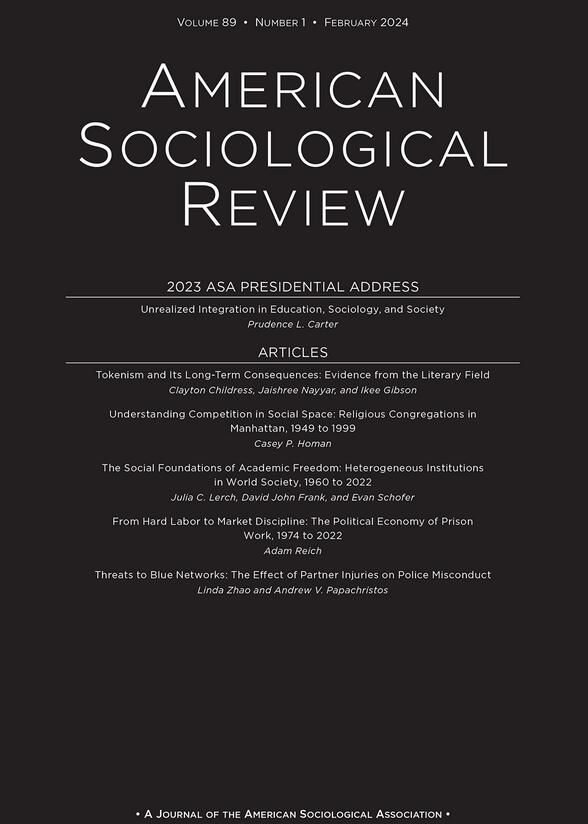疾病的耻辱:不平等的负担,不均衡的下降
IF 6.2
1区 社会学
Q1 SOCIOLOGY
引用次数: 1
摘要
为什么有些疾病比其他疾病更容易被污名化?随着时间的推移,疾病的耻辱感是否有所下降?由于缺乏可比较的纵向数据,这些问题的答案一直受到阻碍。使用词嵌入方法,我们分析了470万篇新闻文章,为1980年至2018年106种健康状况创建了新的耻辱感指标。使用混合效应回归,我们发现行为健康状况和可预防的疾病吸引了最强烈的不道德和负面人格特质的内涵,而传染病最明显地引起厌恶。这些结果为规范执行和避免传染驱动疾病耻感的理论提供了新的实证支持。挑战现有的理论,我们发现没有证据表明医疗化和病耻感之间的联系,以及不确定的证据表明倡导和病耻感之间的关系。最后,我们发现随着时间的推移,耻辱感急剧下降,但仅限于慢性身体疾病。在过去的四十年里,疾病污名已经从围绕大多数疾病的负面内涵的海洋转变为两个主要的意义管道:传染病引发厌恶,行为健康状况引发负面刻板印象。这些结果表明,当文化意义被利益所锚定时,它们尤其持久,文化变化以只有通过大规模研究才能看到的方式交织在一起。本文章由计算机程序翻译,如有差异,请以英文原文为准。
The Stigma of Diseases: Unequal Burden, Uneven Decline
Why are some diseases more stigmatized than others? And, has disease stigma declined over time? Answers to these questions have been hampered by a lack of comparable, longitudinal data. Using word embedding methods, we analyze 4.7 million news articles to create new measures of stigma for 106 health conditions from 1980 to 2018. Using mixed-effects regressions, we find that behavioral health conditions and preventable diseases attract the strongest connotations of immorality and negative personality traits, and infectious diseases are most marked by disgust. These results lend new empirical support to theories that norm enforcement and contagion avoidance drive disease stigma. Challenging existing theories, we find no evidence for a link between medicalization and stigma, and inconclusive evidence on the relationship between advocacy and stigma. Finally, we find that stigma has declined dramatically over time, but only for chronic physical illnesses. In the past four decades, disease stigma has transformed from a sea of negative connotations surrounding most diseases into two primary conduits of meaning: infectious diseases spark disgust, and behavioral health conditions cue negative stereotypes. These results show that cultural meanings are especially durable when they are anchored by interests, and that cultural changes intertwine in ways that only become visible through large-scale research.
求助全文
通过发布文献求助,成功后即可免费获取论文全文。
去求助
来源期刊

American Sociological Review
SOCIOLOGY-
CiteScore
13.30
自引率
3.30%
发文量
35
期刊介绍:
The American Sociological Association (ASA) is a non-profit membership association established in 1905. Its mission is to advance sociology as a scientific discipline and profession that serves the public good. ASA is comprised of approximately 12,000 members including faculty members, researchers, practitioners, and students in the field of sociology. Roughly 20% of the members work in government, business, or non-profit organizations.
One of ASA's primary endeavors is the publication and dissemination of important sociological research. To this end, they founded the American Sociological Review (ASR) in 1936. ASR is the flagship journal of the association and publishes original works that are of general interest and contribute to the advancement of sociology. The journal seeks to publish new theoretical developments, research results that enhance our understanding of fundamental social processes, and significant methodological innovations. ASR welcomes submissions from all areas of sociology, placing an emphasis on exceptional quality.
Aside from ASR, ASA also publishes 14 professional journals and magazines. Additionally, they organize an annual meeting that attracts over 6,000 participants. ASA's membership consists of scholars, professionals, and students dedicated to the study and application of sociology in various domains of society.
 求助内容:
求助内容: 应助结果提醒方式:
应助结果提醒方式:


